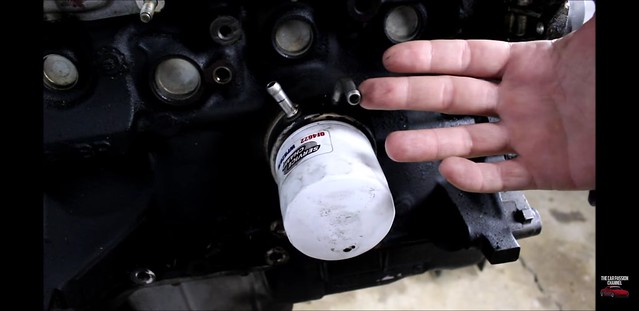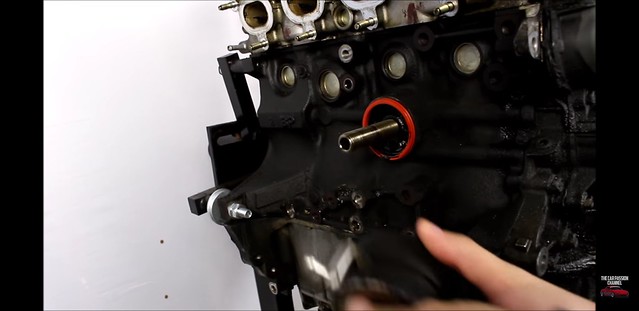Removing factory oil cooler?
#1
Hey guys,
I have a 97', how effective is the factory oil cooler?
Is it possible to remove it and replace it with a sandwich plate (to keep the appropriate spacing for the filter)?

If you don't know, i'm talking about what Greg is pointing to in this picture.

This is whats behind the factory oil cooler, the O-ring looks special but i'm sure I can find one that is not a double lip seal.
Shoutout to Greg at TheCarPassionChannel on YouTube for the pics.
Thanks.
I have a 97', how effective is the factory oil cooler?
Is it possible to remove it and replace it with a sandwich plate (to keep the appropriate spacing for the filter)?

If you don't know, i'm talking about what Greg is pointing to in this picture.

This is whats behind the factory oil cooler, the O-ring looks special but i'm sure I can find one that is not a double lip seal.
Shoutout to Greg at TheCarPassionChannel on YouTube for the pics.
Thanks.
#2
My friend that is an oil heater. For what its worth im going to leave it on when i assembly my built motor. But i have seen people on here remove them without any issues. In theory you can remove it and replace with a sandwich plate as long as it still gets tight. Some people cut the tube or run a tube off the 1.6 then add a sandwich plate as it would be used normally.
#4
It is used to more rapidly warm the oil during startup on cold days. Lots of people remove it to simplify things.
I have mine out right now and I have the mishimoto sandwich plate. The Mishimoto does NOT have the same thickness as the stock oil warmer. So I am probably going to trim down the hollow all-thread post.
Ray
I have mine out right now and I have the mishimoto sandwich plate. The Mishimoto does NOT have the same thickness as the stock oil warmer. So I am probably going to trim down the hollow all-thread post.
Ray
#12
Yeah, new hoses and clamps and they'll last 60-80k, they can be difficult to source at times though. I think all 94-05s have the same 3 hoses, then 1.6s have 4 without the cooler.
And yes, it does cool the oil. Your coolant should never go above 200, even 190 with a good radiator, reroute, and 190* thermostat. Your oil on a spirited drive or track day will reach 250, so a full 50-60f cooler is practically a refrigerator for the oil. These are all naturally aspirated temps from a recent track day.
And yes, it does cool the oil. Your coolant should never go above 200, even 190 with a good radiator, reroute, and 190* thermostat. Your oil on a spirited drive or track day will reach 250, so a full 50-60f cooler is practically a refrigerator for the oil. These are all naturally aspirated temps from a recent track day.
#13
I just bought them from TDR. They had the best options in terms of price and kit modularity if you only want some of the hoses:
https://trackdogracing.com/ahosk.aspx
https://trackdogracing.com/ahosk.aspx
#14
I don't think I've ever had one fail outright. IIRC it's Mishimoto that makes a full silicone kit in the same form as OEM, and those would likely last longer in a track car. I've personally had more trouble with the caps I've used to plug them in the past than I've had with the original hoses.
#15
I don't think I've ever had one fail outright. IIRC it's Mishimoto that makes a full silicone kit in the same form as OEM, and those would likely last longer in a track car. I've personally had more trouble with the caps I've used to plug them in the past than I've had with the original hoses.
--Ian
#16
I'll admit the reason I debated about removing it was I was getting a very small coolant leak from the hoses. I always spray-paint my oil filters white before dropping them in and last oil change there was a nice green tint to the whole filter.
But seeing as it's quite useful I think I'm going to source some nice high temp silicone lines to replace the stock ones, and see if I can't find some small t-bolt clamps for it.
The sandwich plate I mentioned only as a spacer to keep the same dimensions as the stock cooler. I might run one though to have an extra oil temp sensor just in case. Although i've been fine measuring oil temp based on pressure.
But seeing as it's quite useful I think I'm going to source some nice high temp silicone lines to replace the stock ones, and see if I can't find some small t-bolt clamps for it.
The sandwich plate I mentioned only as a spacer to keep the same dimensions as the stock cooler. I might run one though to have an extra oil temp sensor just in case. Although i've been fine measuring oil temp based on pressure.
#17
Has anyone datalogged the water temperature on both sides of this thing? Does anyone know what the water flow looks like?
Temperature delta, and an estimate of the water flow would allow a better judgement of what difference these things make. It would be better to measure oil temp before and after, but that may not be feasible.
Cards on the table, I am a skeptic about their value. If you want to use coolant as a heating/cooling medium, there are better ways.
Temperature delta, and an estimate of the water flow would allow a better judgement of what difference these things make. It would be better to measure oil temp before and after, but that may not be feasible.
Cards on the table, I am a skeptic about their value. If you want to use coolant as a heating/cooling medium, there are better ways.
#18
Gee Emm, while I can't comment on the temperature delta, I can tell you based on my experience with DSMs that the oil coolers are all the same really, water comes in through one tube, goes around the housing a billion times and then comes out the other tube.
I imagine flow would be slightly faster than what the water pump puts out given the smaller diameter tube. The numbers I'm about to state are complete guesses but I suspect it's in the ballpark of a couple PSI, and maybe a liter a minute flow rate? No clue.
The statement: "if you want to use coolant as a heating/cooling medium, there are better ways." Kinda rubs me the wrong way. Why are engines cooled as such then? Water is a beautiful heat transfer medium. I think major gains could be found in oil cooling when you upgrade your radiator or go re-route even. Considering it gets its feed from the rear section of the block, you could see tremendous improvements with a re-route.
I imagine flow would be slightly faster than what the water pump puts out given the smaller diameter tube. The numbers I'm about to state are complete guesses but I suspect it's in the ballpark of a couple PSI, and maybe a liter a minute flow rate? No clue.
The statement: "if you want to use coolant as a heating/cooling medium, there are better ways." Kinda rubs me the wrong way. Why are engines cooled as such then? Water is a beautiful heat transfer medium. I think major gains could be found in oil cooling when you upgrade your radiator or go re-route even. Considering it gets its feed from the rear section of the block, you could see tremendous improvements with a re-route.
#19
Sorry to hear you took it that way. That was a reference to the laminova oil/water heat exchanger that I ran in my racecar, that was plumbed into the radiator outlet. heat exchanger Exactly the same operation as the factory, just massively greater heating/cooling capacity, you need enough radiator cooling capacity though.
paraphrasing Mr Dundee, 'now THAT is a heat exchanger'
DSM?
paraphrasing Mr Dundee, 'now THAT is a heat exchanger'

DSM?
#20
Ah I see what you mean now. That Laminova stuff looks pretty neat, and not a half bad price either. I'd love to see some numbers on that versus the traditional air to oil coolers a lot of people run.
DSM stands for Diamond Star Motors, but it's basically the 90-99 Mitsubishi Eclipse, Plymouth Laser and Eagle Talon. Super cheap FWD/AWD turbo 4 shitboxes that are great for cutting your teeth on and learning how to build motors. They came with the 4G63 engine from Mitsubishi, and they're a blast to mess around with and it's what I learned how to build motors on.
DSM stands for Diamond Star Motors, but it's basically the 90-99 Mitsubishi Eclipse, Plymouth Laser and Eagle Talon. Super cheap FWD/AWD turbo 4 shitboxes that are great for cutting your teeth on and learning how to build motors. They came with the 4G63 engine from Mitsubishi, and they're a blast to mess around with and it's what I learned how to build motors on.












